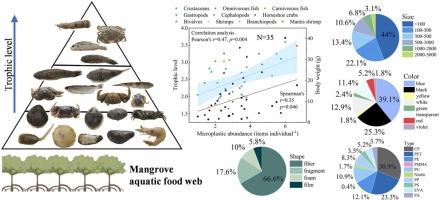Distribution and diversity of microplastics along the aquatic food web in the largest mangrove reserve of China
IF 12.2
1区 环境科学与生态学
Q1 ENGINEERING, ENVIRONMENTAL
引用次数: 0
Abstract
Knowledge of microplastics (MPs) in consumers at different trophic levels and with different feeding strategies in mangroves is essential to evaluate pathways and ecological effects from exposure to MPs. We conducted a comprehensive study on the distribution of MPs along the food web in the largest natural mangrove reserve in China, and applied diversity index of MPs, D’(MP), in terms of color, size, shape and type, to investigate complexity of MPs through the trophic cascades. The highest abundance of total MPs occurred at 5.7±2.6 items/individual in fish, followed by 4.8 ± 1.9, 3.2 ± 0.5, 2.2 ± 0.9 items/individual in crabs, bivalves and shrimps, respectively. There was a correlation between the abundance of MPs in the gastrointestinal tracts (GITs) or soft tissues of organisms and trophic levels (r=0.47, p <0.01), while microplstic abundance were also correlated with body wet weights. The abundance and diversity of MPs in mangrove organisms were influenced by their feeding behaviors and living habitats, as consumers through indirect ingestion had significantly higher abundance of MPs than discriminate feeders. For MPs in their GITs, crabs had the highest shape D’(MP), but the lowest size D’(MP) and color D’(MP), while fish had highest color D’(MP), but significantly lower shape D’(MP). Our application of diversity index of MPs to mangrove ecosystem for the first time reveals a rather complicated distribution of MPs along the aquatic food web, demonstrating an urgent need for measures to reduce the discharge of MPs into mangrove and develop a remediation strategy.

了解红树林中不同营养级和不同摄食策略的消费者体内的微塑料(MPs)对评估接触微塑料的途径和生态效应至关重要。我们在中国最大的天然红树林保护区内对食物网中微塑料的分布进行了全面研究,并从颜色、大小、形状和类型等方面应用微塑料的多样性指数D'(MP)来研究微塑料在营养级联中的复杂性。结果表明,鱼类中MPs的丰度最高,为(5.7±2.6)个/个体,其次是蟹类、双壳类和虾类,分别为(4.8±1.9)个/个体、(3.2±0.5)个/个体和(2.2±0.9)个/个体。生物胃肠道(GIT)或软组织中多孔微囊藻的丰度与营养级之间存在相关性(r=0.47,p <0.01),而微囊藻的丰度与湿重也存在相关性。红树林生物体内微囊藻的丰度和多样性受其摄食行为和生活栖息地的影响,通过间接摄食的消费者的微囊藻丰度明显高于辨别摄食者。就消化道中的多肽而言,蟹类的形状多肽(D'(MP))最高,但大小多肽(D'(MP))和颜色多肽(D'(MP))最低;鱼类的颜色多肽(D'(MP))最高,但形状多肽(D'(MP))明显较低。我们首次将MPs多样性指数应用于红树林生态系统,发现MPs在水生食物网中的分布相当复杂,表明迫切需要采取措施减少排入红树林的MPs,并制定补救策略。
本文章由计算机程序翻译,如有差异,请以英文原文为准。
求助全文
约1分钟内获得全文
求助全文
来源期刊

Journal of Hazardous Materials
工程技术-工程:环境
CiteScore
25.40
自引率
5.90%
发文量
3059
审稿时长
58 days
期刊介绍:
The Journal of Hazardous Materials serves as a global platform for promoting cutting-edge research in the field of Environmental Science and Engineering. Our publication features a wide range of articles, including full-length research papers, review articles, and perspectives, with the aim of enhancing our understanding of the dangers and risks associated with various materials concerning public health and the environment. It is important to note that the term "environmental contaminants" refers specifically to substances that pose hazardous effects through contamination, while excluding those that do not have such impacts on the environment or human health. Moreover, we emphasize the distinction between wastes and hazardous materials in order to provide further clarity on the scope of the journal. We have a keen interest in exploring specific compounds and microbial agents that have adverse effects on the environment.
 求助内容:
求助内容: 应助结果提醒方式:
应助结果提醒方式:


